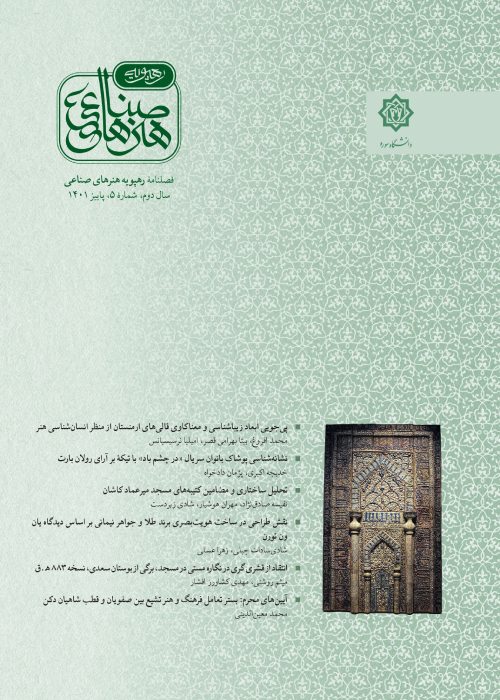Structural analysis and themes of the inscriptions of Mir Emad Mosque in Kashan
Author(s):
Article Type:
Research/Original Article (بدون رتبه معتبر)
Abstract:
The magnificent Arts related to Islamic architecture, especially religious places and mosques, have their own conceptual and aesthetic depth. After the construction of mosques, gradually and throughout history, the decorations related to architecture were upgraded and became more diverse. Looking at the history of religious architecture in Iran from the period of the Khwarazm shahs period until today, countless and valuable examples of mosques can be listed, of which the Mir Emad Mosque in Kashan has a historical position and prestige due to the variety of inscriptions belonging to different periods. Inscriptions with different characteristics such as subject diversity, decorative motifs, performance techniques, and materials, each represent a part of the culture and identity of their era. It seems that this mosque with 32 inscriptions is a suitable case for researching the historical dimensions and explaining the cultural-political themes of the religious monuments of Iran during different periods as a statistical sample (using a targeted census method). For this purpose, the goals of this research were studied in two dimensions: adaptation and rereading of historical dimensions, as well as reading and content analysis of the inscriptions of Mir Emad Kashan Mosque. The method of collecting information in this fundamental research was based on a combination of documentary methods, objective observations, interviews with experts, and field documentation, and the nature of the analysis of the findings was descriptive-historical. Finally, the most critical result deduced from this research showed that out of the four types of inscriptions classified in this mosque, two themes in two sections could be conceived: Religious topics and Quranic verses promoting and explaining the Shia religion in the sections inside the mosque, and the decrees of kings and the rulers of the era with cultural, economic themes and social and moral issues (mostly related to the Safavid era) in the outdoor spaces. These themes are implied through the art of sculpture, plastering and painting on plaster, and the use of Kufi, Sols and Nastaliq calligraphy, each expressing part of the traditions, beliefs, and orders of the rulers of their time on the walls of this significant cultural social building in the Mir Emad complex of Kashan.
Language:
Persian
Published:
Journal of Industrial Arts, Volume:2 Issue: 3, 2022
Pages:
37 to 57
https://magiran.com/p2672576
دانلود و مطالعه متن این مقاله با یکی از روشهای زیر امکان پذیر است:
اشتراک شخصی
با عضویت و پرداخت آنلاین حق اشتراک یکساله به مبلغ 1,390,000ريال میتوانید 70 عنوان مطلب دانلود کنید!
اشتراک سازمانی
به کتابخانه دانشگاه یا محل کار خود پیشنهاد کنید تا اشتراک سازمانی این پایگاه را برای دسترسی نامحدود همه کاربران به متن مطالب تهیه نمایند!
توجه!
- حق عضویت دریافتی صرف حمایت از نشریات عضو و نگهداری، تکمیل و توسعه مگیران میشود.
- پرداخت حق اشتراک و دانلود مقالات اجازه بازنشر آن در سایر رسانههای چاپی و دیجیتال را به کاربر نمیدهد.
In order to view content subscription is required
Personal subscription
Subscribe magiran.com for 70 € euros via PayPal and download 70 articles during a year.
Organization subscription
Please contact us to subscribe your university or library for unlimited access!


